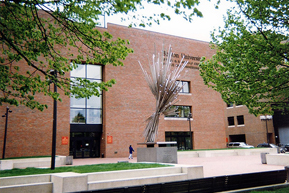Chemical Reaction Causes Brief Evacuation
Comm Ave building and lab reopened, air quality deemed safe

A chemical reaction in a waste storage cabinet at the Metcalf Center for Science and Engineering, 590 Comm Ave, prompted the Boston Fire Department to evacuate the building and issue a level-3 hazmat alert Wednesday night.
There were no injuries and the BFD deemed air quality safe, based on sensor readings. The laboratory cabinet, used to store chemical waste awaiting disposal, sustained minor damage. The building, including the third-floor laboratory, has reopened.
The call came in at 8:49 p.m. Two students working in the lab reported hearing a hissing sound in the chemical storage cabinet before the door burst open and a bottle fell to the floor and broke. Boston EMS, Boston police, Boston University police, staff from Facilities Management & Planning, and staff from BU Environmental Health & Safety responded.
The building was immediately cleared and Boston firefighters set up a decontamination tent on the plaza at 590 Comm Ave. About 30 students were evaluated by EMS and released.
A level-3 hazmat situation means firefighters can’t enter a room unless they are in “fully encapsulated suits and that’s because of the unknown,” says Steve MacDonald, a spokesman for the Boston Fire Department. “Any time we do a laboratory, once we know there’s no life hazard, it’s a very slow, methodical entry procedure. Usually, it takes a minimum of one hour of preparation. The problem with chemicals is that by themselves they’re usually fine; it’s when they mix with something else that the problems occur.”
Mike Penn, senior laboratory safety specialist at BU, says two incompatible chemicals — nitric acid and a small amount of an organic solvent used in a lab experiment — created overpressurization when the waste stream was sealed in a container. The force of the pressure knocked open the cabinet doors.
“It’s not unheard of for this to happen in laboratories,” Penn says. “From what I can remember, in recent history we haven’t had this large a response. We do have small spills. It’s just the nature of research done in laboratories. I’d classify this as a small spill that we were equipped to handle.”
After two hours on the scene, the BFD turned the building over to EHS. “All of our meters read negative as far as any hazardous substances in the air,” MacDonald says.
“Everyone worked really well together, both internally and externally,” says Chris Rowell, EHS fire safety specialist. “We were pleased with how the incident ran. The best part of the whole story is that nobody got hurt. That’s really what’s important — everyone going home safe at the end of the day.”
Caleb Daniloff can be reached at cdaniloff@bu.edu.
Comments & Discussion
Boston University moderates comments to facilitate an informed, substantive, civil conversation. Abusive, profane, self-promotional, misleading, incoherent or off-topic comments will be rejected. Moderators are staffed during regular business hours (EST) and can only accept comments written in English. Statistics or facts must include a citation or a link to the citation.